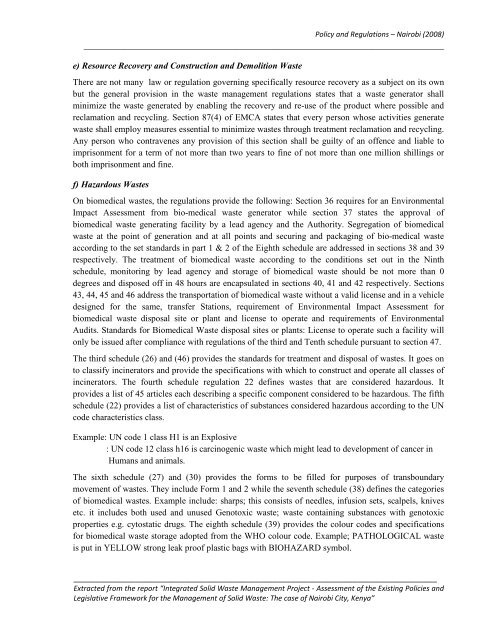Policy and Regulations â Nairobi (Kenya)
Policy and Regulations â Nairobi (Kenya)
Policy and Regulations â Nairobi (Kenya)
You also want an ePaper? Increase the reach of your titles
YUMPU automatically turns print PDFs into web optimized ePapers that Google loves.
<strong>Policy</strong> <strong>and</strong> <strong>Regulations</strong> – <strong>Nairobi</strong> (2008)<br />
_________________________________________________________________________________<br />
e) Resource Recovery <strong>and</strong> Construction <strong>and</strong> Demolition Waste<br />
There are not many law or regulation governing specifically resource recovery as a subject on its own<br />
but the general provision in the waste management regulations states that a waste generator shall<br />
minimize the waste generated by enabling the recovery <strong>and</strong> re-use of the product where possible <strong>and</strong><br />
reclamation <strong>and</strong> recycling. Section 87(4) of EMCA states that every person whose activities generate<br />
waste shall employ measures essential to minimize wastes through treatment reclamation <strong>and</strong> recycling.<br />
Any person who contravenes any provision of this section shall be guilty of an offence <strong>and</strong> liable to<br />
imprisonment for a term of not more than two years to fine of not more than one million shillings or<br />
both imprisonment <strong>and</strong> fine.<br />
f) Hazardous Wastes<br />
On biomedical wastes, the regulations provide the following: Section 36 requires for an Environmental<br />
Impact Assessment from bio-medical waste generator while section 37 states the approval of<br />
biomedical waste generating facility by a lead agency <strong>and</strong> the Authority. Segregation of biomedical<br />
waste at the point of generation <strong>and</strong> at all points <strong>and</strong> securing <strong>and</strong> packaging of bio-medical waste<br />
according to the set st<strong>and</strong>ards in part 1 & 2 of the Eighth schedule are addressed in sections 38 <strong>and</strong> 39<br />
respectively. The treatment of biomedical waste according to the conditions set out in the Ninth<br />
schedule, monitoring by lead agency <strong>and</strong> storage of biomedical waste should be not more than 0<br />
degrees <strong>and</strong> disposed off in 48 hours are encapsulated in sections 40, 41 <strong>and</strong> 42 respectively. Sections<br />
43, 44, 45 <strong>and</strong> 46 address the transportation of biomedical waste without a valid license <strong>and</strong> in a vehicle<br />
designed for the same, transfer Stations, requirement of Environmental Impact Assessment for<br />
biomedical waste disposal site or plant <strong>and</strong> license to operate <strong>and</strong> requirements of Environmental<br />
Audits. St<strong>and</strong>ards for Biomedical Waste disposal sites or plants: License to operate such a facility will<br />
only be issued after compliance with regulations of the third <strong>and</strong> Tenth schedule pursuant to section 47.<br />
The third schedule (26) <strong>and</strong> (46) provides the st<strong>and</strong>ards for treatment <strong>and</strong> disposal of wastes. It goes on<br />
to classify incinerators <strong>and</strong> provide the specifications with which to construct <strong>and</strong> operate all classes of<br />
incinerators. The fourth schedule regulation 22 defines wastes that are considered hazardous. It<br />
provides a list of 45 articles each describing a specific component considered to be hazardous. The fifth<br />
schedule (22) provides a list of characteristics of substances considered hazardous according to the UN<br />
code characteristics class.<br />
Example: UN code 1 class H1 is an Explosive<br />
: UN code 12 class h16 is carcinogenic waste which might lead to development of cancer in<br />
Humans <strong>and</strong> animals.<br />
The sixth schedule (27) <strong>and</strong> (30) provides the forms to be filled for purposes of transboundary<br />
movement of wastes. They include Form 1 <strong>and</strong> 2 while the seventh schedule (38) defines the categories<br />
of biomedical wastes. Example include: sharps; this consists of needles, infusion sets, scalpels, knives<br />
etc. it includes both used <strong>and</strong> unused Genotoxic waste; waste containing substances with genotoxic<br />
properties e.g. cytostatic drugs. The eighth schedule (39) provides the colour codes <strong>and</strong> specifications<br />
for biomedical waste storage adopted from the WHO colour code. Example; PATHOLOGICAL waste<br />
is put in YELLOW strong leak proof plastic bags with BIOHAZARD symbol.<br />
__________________________________________________________________________________<br />
Extracted from the report “Integrated Solid Waste Management Project - Assessment of the Existing Policies <strong>and</strong><br />
Legislative Framework for the Management of Solid Waste: The case of <strong>Nairobi</strong> City, <strong>Kenya</strong>”
















